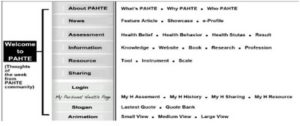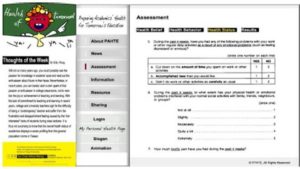Each user’s health history and shared thoughts and information will be built into the “My Personal Health Page” database so that it can be retrieved later by the user when necessary. Besides, a collection of 2D and/or 3D animations related to healthy behaviors for computer use will be established for users’ reference.
In brief, the PAHTE platform not only provides current health-related assessment, but also allows the user to create their customized online health profiling. With the health profiling service, the user may gain a quick glance at their health trend over a certain period of time and decide whether (and how) to adjust the lifestyle correspondingly.
Discussion and Conclusions
Some pioneer users have demonstrated their positive support of the health communication platform. For example, one trial member stated that “Well, I didn’t know that my health status was that bad until I compared my health profiling to my peers.”Another said, “It surely is a good idea to keep track of your health history online for yourself, especially when more and more people have easy access to the Internet nowadays. With this function, the user not only has a chance to compare his/her health profiling to others, but also has the capability of assessing his/her ‘current’ status with‘previous’ status.”
Nevertheless, two practical issues were also raised that needed to be addressed in the initial stage. First, to the researchers’ best knowledge, so far this is the first Internet-based health communication platform with exclusive focus on academics, which would supposedly make it attractive to the targeted population on the one hand.
However, on the other hand, what causes the researchers’ concern is whether the academics would really be willing to spare their valuable time surfing the platform to make full use of its potential benefits if they have been “tied up with academic matters” or “feeling burned-out after work.”Hopefully, as mentioned in one study (Wang & Chern, 2007) that people would conduct health promoting activities if their friends or family suggested that they do so, or if they happened to run into health information campaigns through mass media.
In light of the preceding, the next challenge would be how to make the visit of the health communication platform a routine in academics’ already tied-up daily schedules. Second, the visual demonstration of the user’s health performance compared to the peer seemed appealing and might have the potential to attract academics’ attention to join the community. However, the users would also like to know how to improve the health dimensions with relatively lower scores in comparison with the peer or the past. Therefore, a consultation with domain experts is expected for modification in future studies.
In summary, the fundamental database has been established and the structure and framework of web pages has been developed. The prototype testing is under way.
After completion, a more thorough statistical analysis of hypothesis testing will be conducted to examine whether the users (academics) of this platform demonstrate better health status and perform more healthy behaviors as opposed to the point of time before the use of the health communication platform.
Acknowledgement
Part of the materials was generated from the projects fundedby the National Science Council, Taiwan (NSC 93-2516-S-309-001 / NSC 94-2516-S-309-001).
References
China Times (2011/10/29). “The Over-stressed Academic Profession,” [in Chinese] [Online] [Retrieved July 2, 2012]. Available: http://news.chinatimes.com.
Chu, C., Breucker, G., Harris, N., Stitzel, A., Gan, X., Gu, X. & Dwyer, S. (2000). “Health-promoting Workplaces–International Settings Development,” Health Promotion International, 15 (2), 155-167.
Publisher – Google Scholar – British Library Direct
Deschesnes, M., Martin, C. & Hill, A. J. (2003). “Comprehensive Approaches to School Health Promotion: How to Achieve Broader Implementation?,” Health Promotion International, 18 (4), 387-396.
Publisher – Google Scholar – British Library Direct
Dooris, M. (2001). “The ‘Health Promoting University’: A Critical Exploration of Theory and Practice,” Health Education, 101 (2), 51-60.
Publisher – Google Scholar – British Library Direct
Ferney, S. L. & Marshall, A. L. (2006). “Website Physical Activity Interventions: Preferences of Potential Users,” Health Education Research, 21 (4), 560-566.
Publisher – Google Scholar – British Library Direct
Hoyo-Barbolla, E., Arredondo, M. T., Ortega-Portillo, M., Fernandez, N. & Villalba-Mora, E. (2006). “A New Approach to Model the Adoption of e-Health,” Proceedings of the 13th IEEE Mediterranean Electrotechnical Conference(MELECON 2006). Malaga, 16-19 May 2006, pp. 1209-1212.
Publisher – Google Scholar
Lynagh, M., Schofield, M. J. & Sanson-Fisher, R. (1997). “School Health Promotion Programs over the Past Decade: A Review of the Smoking, Alcohol and Solar Protection Literature,” Health Promotion International, 12 (1), 43-60.
Publisher – Google Scholar – British Library Direct
McKay, H. G., King, D., Eakin, E. G., Seeley, J. R. & Glasgow, R. E. (2001). “The Diabetes Network Internet-based Physical Activity Intervention: A Randomized Pilot Study,” Diabetes Care, 24 (8), 1328-1334.
Publisher – Google Scholar – British Library Direct
Napolitano, M. A, Fotheringham, M., Tate, D., Sciamanna, C., Leslie, E., Owen, N., Bauman, A. & Marcus, B. (2003). “Evaluation of an Internet-based Physical Activity Intervention: A Preliminary Investigation,” Annals of Behavioral Medicine,25 (2), 92-99.
Publisher – Google Scholar – British Library Direct
Papadakis, S. (2001 September). ‘Interactive Computer Technology and Cardiac Rehabilitation,’ CACRC Newsletter.
Preece, J. J. & Ghozati, K. (2001). “Experiencing Empathy Online,” In Rice, RE.and Katz, JE. (Eds.) The Internet and Health Communication: Experiences and Expectations, 147-166. London: Sage.
Publisher – Google Scholar
Rains, S. A. (2008). “Health at High Speed: Broadband Internet Access, Health Communication, and the Digital Divide,” Communication Research, 35(3),283-297.
Publisher – Google Scholar – British Library Direct
Skinner, H. A., Maley, O. & Norman, C. D. (2006). “Developing Internet-based eHealth Promotion Programs: The Spiral Technology Action Research (STAR) Model,” Health Promotion Practice, 7 (4), 406-417.
Publisher – Google Scholar – British Library Direct
Spoel, P. (2008). “Communicating Values, Valuing Community through Health-Care Websites: Midwifery’s Online Ethos and Public Communication in Ontario,” Technical Communication Quarterly, 17(3), 264-288.
Publisher – Google Scholar
Suggs, L. S. (2006). “A 10-Year Retrospective of Research in New Technologies for Health Communication,” Journal of Health Communication: International Perspectives, 11(1), 61-74.
Publisher – Google Scholar – British Library Direct
Wang, S. Y. & Chern, J. Y. (2007). ‘Discord of Health Belief, Health Behavior, and Health Status among Taiwanese Academics,’ Presented at the 19thIUHPE World Conference on Health Promotion and Health Education, June 10-15, 2007, Vancouver, BC, Canada.
Google Scholar
Ward, D., Saunders, R., Felton, G., Williams, E., Epping, J. & Pate, R. (2006). “Implementation of a School Environment Intervention to Increase Physical Activity in High School Girls,” Health Education Research, 21 (6), 896-910.
Publisher – Google Scholar – British Library Direct
Winett, R. A., Tate, D. F., Anderson, D. S., Wojcik, J. R. & Winett, S. G. (2005). “Long-term Weight Gain Prevention: A Theoretically Based Internet Approach,” Preventive Medicine, 41 (2), 629-641.
Publisher – Google Scholar
World Health Organization (1986). “Ottawa Charter for Health Promotion,” [Online], WHO, Geneva.[Retrieved July 2, 2012].Available: http://www.who.int/healthpromotion/conferences/previous/ottawa/en/index.html
Publisher
World Health Organization (2007). Global School Health Initiative. [Online], WHO, Geneva.[Retrieved July 2, 2012]. Available: http://www.who.int/school_youth_health/gshi/en/
Publisher






